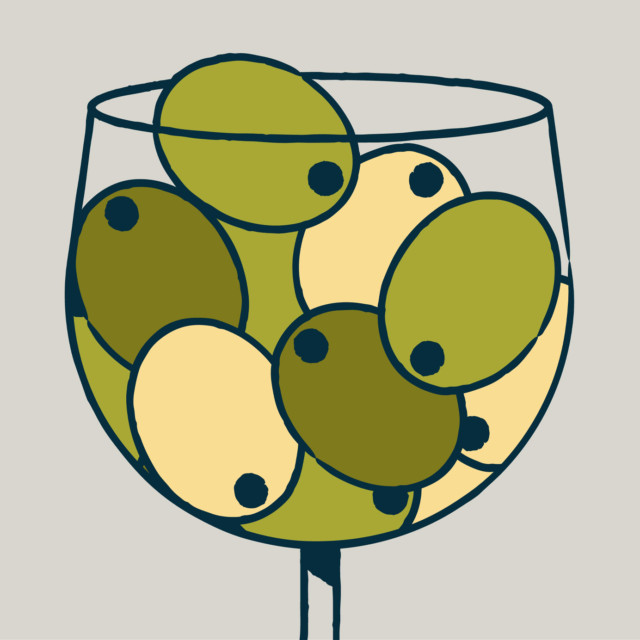Daniel Daou of Daou Vineyards in Paso Robles has a theory about the role phenolics, or micronutrients only found in plants, play in consistently highly rated vintages of wine. “Look at a good year versus a bad year in Bordeaux,” Daou says. “Same winemaker, chateau, and vineyard, but the conditions climatically are different. A good vintage is going to be darker, more structured, more aromatic. These factors are directly related to the quality of the wine.” Grapes and olives, just like any other plant, respond to their environment. Varying levels of sun, heat, water, and soil composition directly affect the quality of a vineyard or olive grove. The saying “we are what we eat” rings just as true for plants as it does for humans — which means that your favorite wine and olive oil have a lot more in common than you might realize.
Daou, who also mills olive oil from the trees grown on his property, has three main measurements of quality for both: color, density, and taste. “Color is directly correlated to texture, which is directly correlated to density. A wine that is more textural and more dense is a superior wine,” he explains. The chemical compounds called phenols are the result of those environmental conditions and are expressed in 20 different phenols found in the skin, flesh, and seeds of the fruit. Phenols are the reason that wine and extra-virgin olive taste good in the first place. Both fruits contain varying amounts of flavonoids, anthocyanins, and tannins; flavonoids are responsible for aromatics and flavor, anthocyanins for color, and tannins for structure and astringency. Daou says that balancing them is the key.
“In the past, say, 20, 30, or 40 years, people used to measure phenolics; it was very hard to determine if they played a role in the quality of the wine,” Daou notes. Through trial and error, he reverse-engineered this process by looking at the color, density, and flavor of some of the highly rated wines that he wanted to emulate. Upon digging into the statistics, he noticed a trend: Vintages with smaller berries, more skin, less juice, and more concentration consistently came out on top. By dry farming, Daou was able to achieve a more concentrated juice that balanced the higher level of tannins extracted from the skin and led to a richly colored, complex, and flavorful wine with good structure. “It applies to any fruit,” he says. “Have you ever eaten those wild raspberries that are small and tiny and explode in your mouth?” A heavy rain year will lead to a watered-down batch of fruit.
The specific phenols related to color only occur in ripe fruit skins, so for extra-virgin olive oil, the parameters are slightly different. Salvatore Bono, olive oil sommelier and owner of Bono Olive Oil, explains that color relating to quality is a “big myth” in olive oil, because color is really just determined by olive varietal. This means that olives with fully matured, darker skins aren’t preferable to green fruit with more of the peppery, pungent phenols. Olives are traditionally harvested in October through December, resulting in a mix of less ripe and more ripe fruit, which means that the best oils not only have some color, but also a peppery bite.
Recognizing high levels of phenols in quality wine and oil is less daunting than it sounds because ultimately, both wine and olive oil should both just taste really good. But what exactly does tasting good mean? A “good” California red will have “balanced levels of flavor,” says Daou. A bad wine will have too much sweetness or acid and taste thin on the tongue. The same can be said for an olive: The smaller and more concentrated the olives are, the more polyphenols you’re going to have.
Unsurprisingly, the type of olives used makes all the difference in terms of oil quality. Dr. Limor Goren of Kyoord recently teamed up with a Greek olive oil producer based in Corfu to make high- phenolic extra-virgin olive oil. She notes that the Greek kalamata olive has high levels of one phenol but isn’t balanced, which is why it’s more of a table olive. Goren, a molecular biologist who stumbled into a passion for phenolics, says her personal favorite high-phenolic olives are the lianolia, which are the one only grown in Corfu. The most common Greek olive, koroneiki, also produces very high-phenolic olive oil and is balanced.
When it comes to splurging on extra-virgin olive oil, Bono encourages people to shop around. While branding jargon can be misleading, cold pressed is still the No. 1 phrase that matters. He also suggests avoiding “light” olive oils, which are the result of adding heat to olive mash after the first cold press to extract more oil. Meanwhile, Goren sides with choosing a certified PDO or PGI (European certification) extra-virgin oil. “These certifications guarantee the origin and traceability of the oil linked to a specific geographical area but also certify the high quality which is guaranteed and controlled,” she explains. Regionality also matters. “If we pay close attention choosing a good wine — for example, Chianti from Tuscany — we should also do in the same way with an extra- virgin olive oil — for example, PDO Val di Mazara from Sicily,” Bono explains.
Ultimately, a good year for wine will most likely be a good year for olive oil. If your favorite winery sells its own olive oil, chances are it’s fresh with many of the same qualities found in its wine. Whenever possible, look for the harvest date from the most recent harvest year and use it often.
